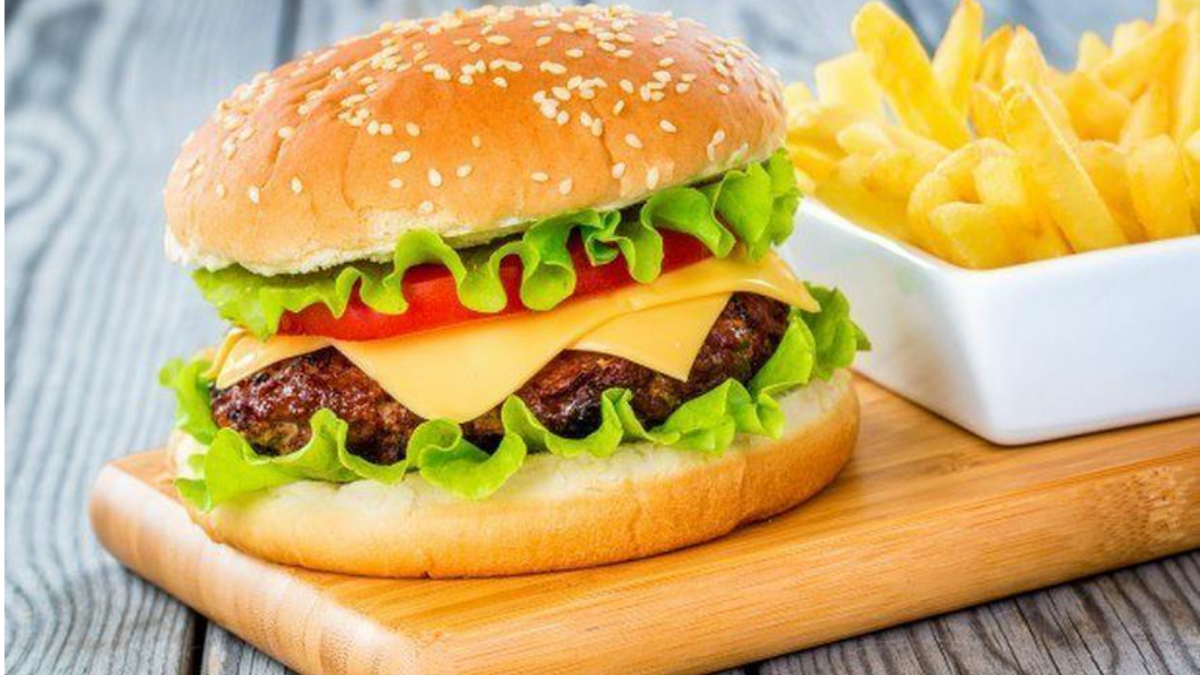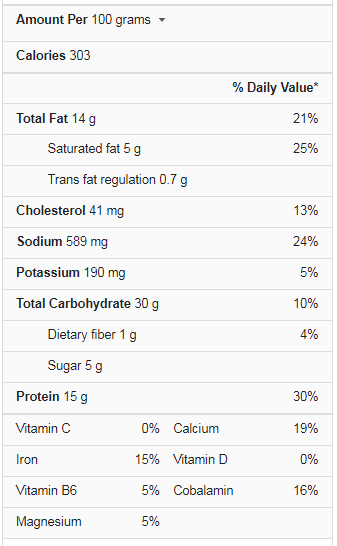A juicy cheeseburger is a favourite of most people. But the calories in a cheeseburger may pile up rapidly. Although avoiding eating fast food cheeseburgers regularly is preferable, there are methods to include this dish in your diet. There are methods to make a cheeseburger healthier, which can have some nutritional advantages. Most Americans make sure to include this food item in their diets and meals, but far too few are aware that they can truly be healthy if they are balanced with other nutritious foods and nutrition tracking.
A cheeseburger is simply a hamburger with cheese on top. The piece of cheese is typically placed on top of the meat patty. Shortly before serving, the cheese is typically added to the cooked hamburger patty, allowing it to melt. The composition, ingredients, and construction of cheeseburgers might vary. A cheeseburger, like other hamburgers, can be topped with items like lettuce, tomato, onion, pickles, bacon, mayonnaise, ketchup, and mustard.
Cheeseburger Nutrition Facts
What is Exactly Cheeseburger?
A cheeseburger, a hamburger with a piece of cheese, is frequently regarded as a staple of traditional American cuisine. Even though this sandwich is widely blamed for contributing significantly to the obesity crisis in the US, it is a treat that doesn’t seem to be going away anytime soon.
Unfortunately, there is some disagreement over who should be given credit for creating the cheeseburger. Time magazine claims that in 1924, while Lionel Sternberger was a high school student working part-time at his father’s grill in Pasadena, California, he created the cheeseburger. However, both the Humpty Dumpty Barrel Drive-In in Denver, Colorado and Kaelin’s Restaurant in Louisville, Kentucky, assert that they created this beloved American dish.
There are many places to get cheeseburgers, but it may take trial and error to locate one you like. The cheeseburgers served at fast-food joints like McDonald’s or Burger King and the pre-cooked microwaveable burgers sold at gas stations or convenience stores are convenient. Still, they’re in a different culinary league from the homemade cheeseburgers prepared by amateur chefs at backyard barbecues or the specialty burgers offered at some upscale dining establishments across the country.
What’s the Healthiest Cheese for a Cheeseburger?
Usually, burger lovers choose the best cheese for their meal based on the flavor and how well the cheese melts. But are some burger cheeses healthier than others? Yep, but not by a great margin. Here’s how some of the most popular cheeses stack up.
- American cheese: 106 calories, 9 grams of fat
- Cheddar cheese: 114 calories, 9 grams of fat
- Pepper jack: 110 calories, 9 grams fat
- Blue cheese: 100 calories, 8 grams of fat
- Swiss cheese: 95 calories, 7 grams of fat
- Brie cheese: 100 calories, 8 grams fat
- Mozzarella cheese (part-skim): 79 calories, 5 grams of fat
When adding cheese to a burger, remember that serving size makes a significant difference. For each cheese, the calorie numbers given are for one ounce. However, pre-cut slices frequently weigh less than an ounce, so you might be able to reduce your calorie intake by utilizing the smaller serving.
Additionally, if you select a cheese with a stronger flavor, you might use less of it. Because of this, using pepper jack or brie may let you reduce your calorie intake.
Last but not least, remember that adding cheese will raise the sodium level of your hamburger. So you might want to omit the cheese if you’re attempting to reduce your salt intake.
How to Make Cheeseburger Healthier?
Creating your cheeseburger at home is the best method to reduce the amount of fat, calories, and sodium in it. It would help if you grilled your burger to allow the fat to escape from the meat and avoid using extra oil or butter for cooking the patty. Instead of the typical 80/20 chuck, you can substitute leaner ground beef, bison, turkey, or chicken.
Once your burger is prepared, use caution while adding toppings and sauces. Popular toppings like bacon will drastically increase your fat and calorie intake. So you might wish to disregard those choices. Put as much lettuce, tomato, and onion as possible.
Avoid mayo, barbeque sauce, and other fatty condiments as well. A tasty condiment option is mustard, and cheese will also provide a lot of delicious flavors. And think of utilizing only half a bun, and the calories in a hamburger bun can increase by 100 to 200. Try an open-face burger or lettuce-wrap the entire patty.
Finally, order your cheeseburger sides wisely. Even coleslaw is packed with calories and french fries and onion rings. Pick some fresh fruit or a small salad on the side of the burger that isn’t filling enough on its own. And to quench your thirst, sip water. A milkshake can easily add three times as many calories to your daily total as a cold beer, which would often add 150 calories or more.
How Healthy is Cheeseburger?
Cheeseburgers may not even cross their minds as an option for individuals attempting to maintain a healthy diet and get in shape (but perhaps the most common food to crave).
However, there’s no need to indulge more because cheeseburgers include a wealth of nutritional and health advantages that you would not want to forgo, in addition to the apparent pleasure of taste.
Protein Booster
Almost every cell in our body cries out for proteins, and red meats are a rich source of those proteins. Since proteins are constantly consumed and broken down, they must be continuously supplied. A significant protein deficiency may result in issues with nutrition and loss of biological processes. A daily protein consumption of 46 grams for women and 56 grams for men is advised for adults.
Good Source of Iron
The red beef used in cheeseburgers is a wholesome component and is regarded as a reliable source of iron. For all of the cells in our body to continue functioning, oxygen must be delivered, and iron is crucial to this process. The body can function at its best when cells take in enough oxygen.
Fresh Red Blood Cells
Red meat is a strong source of iron and is also high in vitamin B-12. Every 120 days, new red blood cells are produced, a process made possible by vitamin B-12. For adults, 2.4 micrograms of vitamin B-12 are needed daily, and this amount rises to 2.6 micrograms each day during pregnancy.
Keep your Cells Energized
Additionally, rich in vitamin B-6 is the lean beef used in cheeseburgers. This vitamin is necessary for producing heme, a vital component of hemoglobin. Because hemoglobin lacks heme, it cannot transport oxygen from and into cells, which causes cells not to satisfy their minimal energy needs.
Fight Cancer
Do hamburgers aid in the fight against cancer? That seems crazy. However, researchers at the University of Wisconsin’s Food Research Institute discovered in 1978 that a certain component of grilled hamburgers could inhibit the formation of cancer cells. The ingredient is a healthy lipid known as CLA (Conjugated Linoleic Acid).
More Advantages of Cheeseburger
Here are more health benefits of cheeseburgers:
Differences Between Hamburgers and Cheeseburgers
Here are some main points of differences between hamburgers and cheeseburgers:
- A hamburger is ground beef or meat patty sandwiched between two buns. On the other hand, the cheeseburger consists of a burger patty with a piece of cheese on top.
- Hamburgers first came into existence in the year 1885. On the other hand, cheeseburgers first came into existence in the year 1924.
- Hamburger is derived from a place in Germany called Hamburg. On the other hand, the cheeseburger is a combination of cheese and hamburger.
- Louis Lassen first invented the hamburger. On the other hand, the cheeseburger was first invented by Lionel Sternberger.
- The benefits of eating a hamburger are it will improve weight gain and add metabolism to your body. On the other hand, the benefit of eating cheeseburgers is it creates and manages red blood cells in the body.
How to Reheat a Cheeseburger?
Although leftover cheeseburgers are a fantastic lunch and supper choice, they lose some of their freshness after spending the night in the refrigerator. The key to successfully reheating a cheeseburger is to separate the patties and bun and heat them separately before reassembling the burger. Using your microwave, oven, or stovetop, you can have a delectable and warm cheeseburger in a matter of minutes.
- Let the Burger Rest at Room Temperature for 10 Minutes: Place the entire cheeseburger on a table or surface and let it warm up. As a result, it is simpler for the burger to maintain an equal temperature during the warming process. Make sure that you don’t leave the meat out for more than 2 hours, or else it might go bad.
- Separate the Burger Contents onto a Flat Surface: Take the cheeseburger apart on top of a cutting board or piece of paper. Sort the buns, burger patties, toppings, and condiments into various piles to make the burger. You don’t want to be biting into heated vegetables when you go to eat the burger.
- Scrape the Cheese and Condiments off the Patty and Buns with a Dinner Knife: Some of it can stay, but the majority needs to go. In any case, adding new condiments will make the burger taste lot more flavorful and fresh. Although keeping the cheese on the burger patty won’t affect how it reheats, it may melt off in the process.
- Examine the Vegetables and Other Toppings for Freshness. You might need to discard lettuce and tomatoes because they have a propensity to become mushy while being stored. Pickles, onions, bacon, and other toppings with less water content usually work out OK and can be kept. If you want your burger to taste as fresh as possible, consider adding new slices of tomato, lettuce, and onions.
Conclusion
As we just covered, it is a hamburger with cheese. The cheese will be placed on top of the frying hamburger patty before serving, and the heat will cause the cheese to melt automatically. They differ in terms of their content, structure, and constituents. In America, the McDonald’s cheeseburger is particularly well-liked. Pickles, ketchup, a slice of melted American cheese, chopped onions, and mustard sauce are added as toppings. A thin piece of cheese is utilized in the cheeseburger. They won’t sprinkle cheese cubes or grated cheese on top of it. Its original name was Cheese Hamburger.



